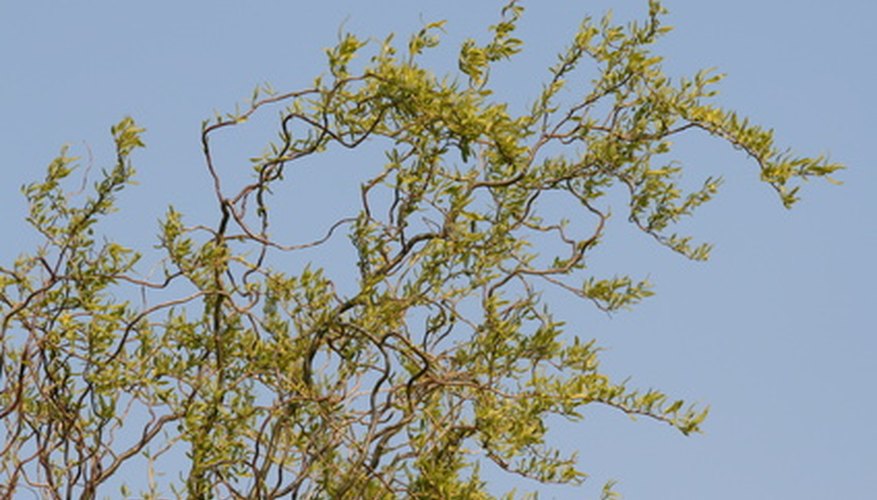Curly willow (Salix matsudana) is often grown for flower arrangements because its twigs have an interesting curvy form. It can grow as fast as 1.5 to 1.8 m (5 to 6 feet) per year, topping out at 7.5 9 m (25 to 30 feet). Like most varieties of willow, curly willow needs intensive pruning to keep its brittle wood from cracking and splitting. Pruning strategies can vary according to your intention; prune to keep a shrublike form that grows multiple trunks and dense branches, or prune for height, a single trunk and a treelike form with a strong structure.
Pruning as a shrub
Prune in February when curly willow is completely dormant. Put on a pair of canvas gloves to protect your hands from the thorns, and cut the main branches back to about 20 cm (8 inches) from the ground. This will cause vigorous, multiple sprouts in the spring.
Allow curly willow to grow into a dense shrub during the growing season. It will reach to your waist or possibly to shoulder height. Clip branches and branch tips with short-handled pruning shears and use them for height and interest in flower arrangements.
Repeat the rejuvenation pruning the following February to maintain a shrublike form. Cutting curly willow back severely each year does not harm it because its growth habit is much like that of a butterfly bush. It will return to waist or shoulder height every time.
- Prune in February when curly willow is completely dormant.
- Cutting curly willow back severely each year does not harm it because its growth habit is much like that of a butterfly bush.
Rake up and bag pruned twigs, branches and leaves for disposal. Curly willow is susceptible to many insect pests and diseases that can be attracted by dead and decomposing plant material.
Pruning as a tree
Prune away multiple trunks of curly willow 2.5 cm (1 inch) or so above the soil line with a pruning saw, leaving the strongest trunk. Trim off shoots and small branches from the bottom third of the trunk. Set the blades of the shears at a 45-degree angle, cutting down and out to leave a small stub.
- Prune away multiple trunks of curly willow 2.5 cm (1 inch) or so above the soil line with a pruning saw, leaving the strongest trunk.
Thin the canopy of the curly willow to allow good light and air penetration throughout the tree. Reducing weight on upper branches will make them less prone to splitting at the crotch in windy or harsh weather.
Prune out dead and damaged wood at any time of year, whenever you see it. Bag and discard fallen leaves at the end of autumn to avoid attracting insects, fungus and powdery mildew.
TIP
Curly willow thrives in damp soil. If you've planted it high and dry, water frequently.
WARNING
Curly willow is not suitable for tree lawns because of its short lifespan and brittle wood. Nor should it be planted near water or sewer lines, because its extensive root system can damage them in its search for water.
